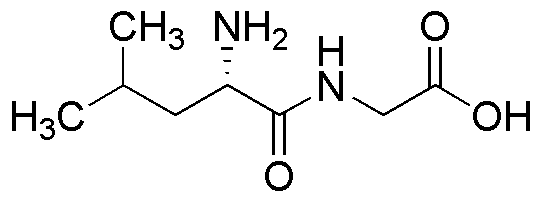Leu-Gly-OH is widely utilized in research focused on:
- Peptide Synthesis: This compound serves as a building block in the synthesis of peptides, which are crucial in drug development and biochemistry.
- Pharmaceutical Research: It plays a role in the formulation of therapeutic agents, particularly in developing treatments for metabolic disorders.
- Protein Engineering: Researchers use it to modify proteins, enhancing their stability and functionality for various industrial applications.
- Cosmetic Formulations: Its properties are leveraged in skincare products for their moisturizing and anti-aging benefits, appealing to the cosmetics industry.
- Biotechnology: It is used in the production of recombinant proteins, which are essential for vaccines and diagnostic tools.
Información general
Propiedades
Seguridad y normativas
Aplicaciones
Leu-Gly-OH is widely utilized in research focused on:
- Peptide Synthesis: This compound serves as a building block in the synthesis of peptides, which are crucial in drug development and biochemistry.
- Pharmaceutical Research: It plays a role in the formulation of therapeutic agents, particularly in developing treatments for metabolic disorders.
- Protein Engineering: Researchers use it to modify proteins, enhancing their stability and functionality for various industrial applications.
- Cosmetic Formulations: Its properties are leveraged in skincare products for their moisturizing and anti-aging benefits, appealing to the cosmetics industry.
- Biotechnology: It is used in the production of recombinant proteins, which are essential for vaccines and diagnostic tools.
Documentos
Hojas de datos de seguridad (HDS)
La SDS proporciona información de seguridad completa sobre la manipulación, el almacenamiento y la eliminación del producto.
Especificación del producto (PS)
La PS proporciona un desglose completo de las propiedades del producto, incluida la composición química, el estado físico, la pureza y los requisitos de almacenamiento. También detalla los rangos de calidad aceptables y las aplicaciones previstas del producto.
Certificados de análisis (COA)
Busque certificados de análisis (COA) ingresando el número de lote del producto. Los números de lote y de partida se pueden encontrar en la etiqueta de un producto después de las palabras "Lote" o "Lote".
Número de catálogo
Número de lote/lote
Certificados de origen (COO)
Este certificado de origen confirma el país en el que se fabricó el producto y también detalla los materiales y componentes utilizados en él y si se deriva de fuentes naturales, sintéticas u otras fuentes específicas. Este certificado puede ser necesario para cumplir con las normativas aduaneras, comerciales y regulatorias.
Número de catálogo
Número de lote/lote
Hojas de datos de seguridad (HDS)
La SDS proporciona información de seguridad completa sobre la manipulación, el almacenamiento y la eliminación del producto.
DownloadEspecificación del producto (PS)
La PS proporciona un desglose completo de las propiedades del producto, incluida la composición química, el estado físico, la pureza y los requisitos de almacenamiento. También detalla los rangos de calidad aceptables y las aplicaciones previstas del producto.
DownloadCertificados de análisis (COA)
Busque certificados de análisis (COA) ingresando el número de lote del producto. Los números de lote y de partida se pueden encontrar en la etiqueta de un producto después de las palabras "Lote" o "Lote".
Número de catálogo
Número de lote/lote
Certificados de origen (COO)
Este certificado de origen confirma el país en el que se fabricó el producto y también detalla los materiales y componentes utilizados en él y si se deriva de fuentes naturales, sintéticas u otras fuentes específicas. Este certificado puede ser necesario para cumplir con las normativas aduaneras, comerciales y regulatorias.

